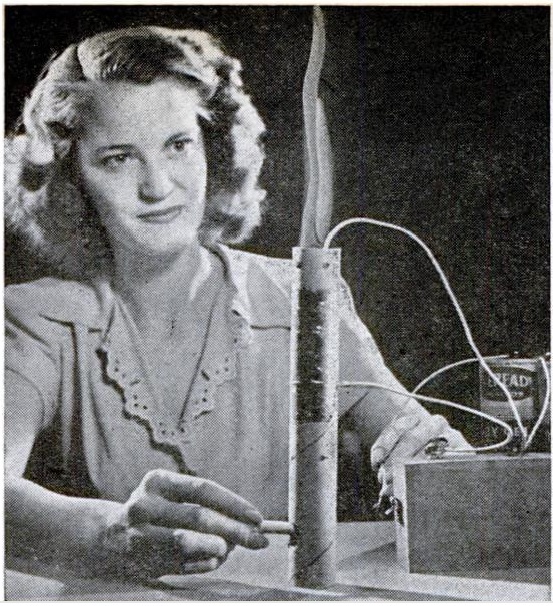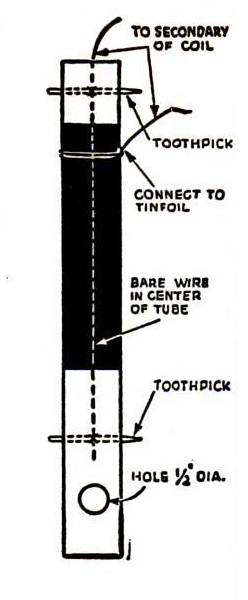
 Seventy-five years ago this month, this young woman undoubtedly took home the blue ribbon of the 1946 Science Fair with this experiment in which she constructed an electrostatic precipitator to fight air pollution. In the photo above, a column of smoke is rising. But the moment she flips the power switch on her precipitator, the smoke ceases. An electrostatic precipitator, known at the time as a Cottrell precipitator after its inventor Frederick Gardner Cottrell, removes particulate matter from the air through an electric charge, but does not affect the flow of gas. The same principle is used in home air purifiers such as this:
Seventy-five years ago this month, this young woman undoubtedly took home the blue ribbon of the 1946 Science Fair with this experiment in which she constructed an electrostatic precipitator to fight air pollution. In the photo above, a column of smoke is rising. But the moment she flips the power switch on her precipitator, the smoke ceases. An electrostatic precipitator, known at the time as a Cottrell precipitator after its inventor Frederick Gardner Cottrell, removes particulate matter from the air through an electric charge, but does not affect the flow of gas. The same principle is used in home air purifiers such as this:
In the 1946 experiment, a column of polluted air passes through a mailing tube, where it passes through a high voltage electric field. Particulate matter clumps together as a result of the electric charge, and falls to the bottom of the tube.
We enjoy providing inspiration for projects such as these, and we hope modern school children can do the same experiments. And for this project, your young scientist will need the following items. Where available, we have provided links to Amazon:
- Mailing tube
- Toothpicks
- Foil
- Wire
- Model T spark coil
- Cigarette
As you see, Amazon no longer has all of the needed parts. The Model T spark coil is apparently out of production. And while this young woman had no problem bringing a pack of Chesterfields to school and nonchalantly lighting one up in the science classroom to show off her invention, it’s no longer 1946. If a kid did that today, they would probably get expelled. So if Junior wants to do this experiment today, some modification is necessary.
Fortunately, as long as your young scientist has some creativity, substitutions shouldn’t be a problem. In place of the cigarette, the original 1946 experiment allows for the use of an incense stick, and as long as Junior has the teacher’s permission, this shouldn’t be a problem.
The Model T spark coil, however, is a bit more problematic. The spark coil from a Model T was known as a trembler coil. The device was a transformer. To be able to operate with DC, the coil operated in interrupter: When voltage was applied to the coil, the magnetic field opened the contacts of the interrupter, which turned off the coil. With the coil off, the contacts closed, allowing the coil to re-energize. The result of this on-off action was an alternating current, and the voltage of this alternating current was stepped up to thousands of volts with the transformer.
The Model T spark coil remained in production for many years after the last Model T rolled off the assembly line, and many of them found their way into things other than cars. When this experiment was published in Popular Science in December 1946, there was apparently no question that if you wanted a Model T spark coil, that finding one wouldn’t be a problem. One popular use of the coil in the early days of radio was for use in a spark-gap transmitter.
But if you walk in to the parts counter of your local Ford dealer today, they probably don’t have them any more. (On the other hand, there are still Model T’s on the road, and if you want to buy a new spark coil, they are still being made, but they’re probably too expensive, such as this one.)
The advanced student should be able to build their own induction coil. They will need a transformer and a method of interrupting the current. Experimentation with a filament transformer and mechanical buzzer will probably prove fruitful. Our earlier post describing a spark coil should give the advanced student enough information to construct one that is essentially identical to the Model T version.
The school might already have the equivalent stashed away in the back room of the science lab, or you could convince the teacher to spend some of the science budget on one of these:
Some links on this site are affiliate links, meaning that this site earns a small commission if you make a purchase after clicking on the link.
